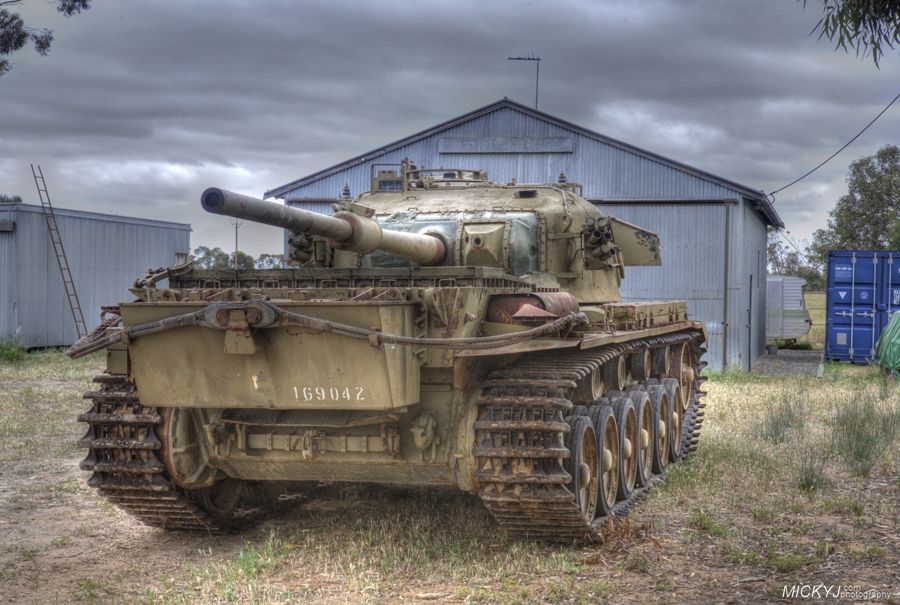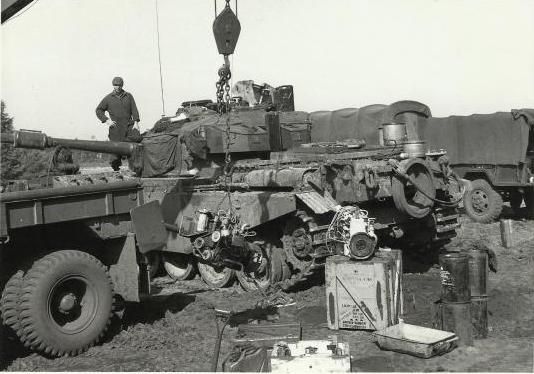
 |
|
|
|
#1
|
||||
|
||||
|
Mike,
Tonight I've selected a photograph of an Australian Centurion taken by a Michael Jenkin. It's entitled 'Standing Guard' and the comment attached to it says "Coomandook - Dukes Highway - Centurion Tank ARN 169042".  The website that I downloaded this from gives a detailed history of this vehicle, the Centurion and its service in Vietnam. Now let's see if I've learned anything about the Centurion over this past week. This vehicle is armed with a 20-pdr Type B barreled main gun with at least three, if not four, counter weights welded to the fume extractor. (They appear to have been welded parallel and cross-ways to the barrel.) The mantlet is not shrouded in a single piece of painted canvas like British and Canadian Centurions but has a closely fitting piece of canvas covering the main gun and exposing the co-axial machine-gun mount. It's fitted with the 100-gallon auxiliary gas tank with the infantry phone fitted to its left side. The barrel yoke, or crutch as you have referred to it, is open and leaning against the depression stop rail. There is what appears to be an aperture inboard of the co-axial machine gun which may be for a .50-cal ranging machine gun. There are two antenna mounts on the turret roof. I don't know if they are British or American type mounts. Finally, as the turret reloading door is visible I would say that the forward bin box has been removed. I would say it's a Mk 5 possibly with an RMG. What say you? Cheers, Dan. |
|
#2
|
||||
|
||||
|
Mike,
Talk about making a bone move in my previous post. I've just found the site called 'centurion-mbt-two' wherein you provided the detailed history of the Centurion I featured in my previous post. It also has all of Michael Jenkin's photographs. I guess I should've stuck to asking questions about Canadian vehicles instead of trying to show off. Tomorrow I'll have some questions about uparmouring the glacis. Cheers, Dan. |
|
#3
|
|||
|
|||
|
No worries, Dan, happy to answer questions about Cents (the Australian usage has been something of a research project for many years).
I find my 'detailed histories' of individual Centurions popping up in all sorts of places, most without the courtesy of seeking permission and many without crediting me. I'm told by one website (that I do willingly write for) that the article I wrote on 169041, the 'Atomic Tank' as I dubbed it, has been viewed and copied/downloaded many thousands of times. I suppose I should take that as a compliment to the research effort it took to write it. The website you refer to is a particular 'vacuumer' of Cent info and images from all sorts of places. 169042 is indeed a Mk.5/1, but the Australian 'version' with .50 inch L6A1 RMG mounted in place of the .30 cal, which is moved to the right closer to the 20-pdr main armament. The three weights are all parallel to the barrel of the 20-pdr - they are to provide balance at the gun trunnions. Most Aust Cents with B type barrels have three weights, but as few as one large one and as many as 7 have been noted. The weights are not necessarily uniform in size. The extra weights are required to compensate for the additional weight of the combined 30-cal & RMG mount, RMG, and ammo. The RMG combined with the 20-pdr is unique to Australia. The Poms tested the concept of an RMG with that combination on a couple of tanks in the late 50s, then combined the RMG ONLY with the 105mm L7 for service use. The Infantry tank telephone is indeed mounted to the left side of the auxiliary armoured fuel tank, but horizontally, not vertically. There are also some other aspects that are peculiar to Aust Cents, such as the brush guard in front of the gunner's sight. The radio setup is British: a Larkspur SW C42/B47 combination. Regards Mike C |
|
#4
|
||||
|
||||
|
Mike,
Further to the adding of an armour plate to the glacis of the Centurion, I have a few questions. I'm guessing that whatever was already welded to the glacis of a Mk 3 needed to be removed prior to the addition of a new plate. (I'm assuming that it was a single plate of steel, for strength integrity purposes.) When the various furniture that was required on the front of the vehicle was added again, was there a new arrangement that made it visibly different from earlier? Was a plate also added to the bottom of the front of the tank? The part of the bottom that comes up to meet the glacis? Is there a way to immediately tell if the vehicle one is looking at is a Mk 5/1 (uparmoured) or not, especially from a distance or from a side view? Finally, was uparmouring a process that could be accomplished at a Base Workshop or did each vehicle have to go for a full factory refurbishment? Cheers, Dan. |
|
#5
|
|||
|
|||
|
Hi Dan,
The uparmour plate came as a war office kit with installation instructions. First: remove all the 'stuff' from the glacis, weld glacis, re-locate all the 'stuff' back into place. There were plenty of exceptions, however, depending on other requirements and installations, but in general, it was a straightforward process. The plate was to ensure a degree of frontal arc immunity to the Russian/Soviet APDS round fired by the T54. The uparmour was only added to the upper sloping glacis plate. There are a few visible traits: the plate is cut around the towing eye mounts, and there is a chamfering effect let into the top edge of the plate in front of the driver: these can often be readily seen from the front. From the side, the plate is thicker at the top edge, and sticks out a fraction (1.5 inches, I think). Yes, a tank/heavy machinery Base Workshop could handle it: just so long as they had the arc welding capacity. In Australia, it was most often done at rebuild by Bandiana Area Workshop, or to tanks already rebuilt but held in storage at 1COD awaiting issue. Mike C |
|
#6
|
||||
|
||||
|
Mike,
Going back to the first post of this thread, here is the one supposedly depicting a Centurion engine change.  The tank appears to be a Mk 5/1 with a Type B barrel. There is something strange between the bin boxes on the left side of the turret, covering the ammunition loading hatch. There's also the strange placing of the road wheel on the back of the 100-gal tank. Most photos from this time period (mid-60's) show the road wheel located on the rear of the turret where the track-link holders are. It also looks like the infantry telephone is on the rear of the fuel tank, rather than the left side. I'm sure the Centurion spent as much time in the field in this environment as it did on the ranges and in laager. Cheers, Dan. |
|
#7
|
|||
|
|||
|
The engines (one on the hook and one sitting on the crate) look small for truck engines as well. The layout of the small engines looks similar to the image of the charging set engine shown in the User Handbook for the Centurion Mks. 3 and 5 dated 1953. The attached diagram (PDF version 7 or later) is from that manual.
|
 |
| Thread Tools | |
| Display Modes | |
|
|